November 11, 2007
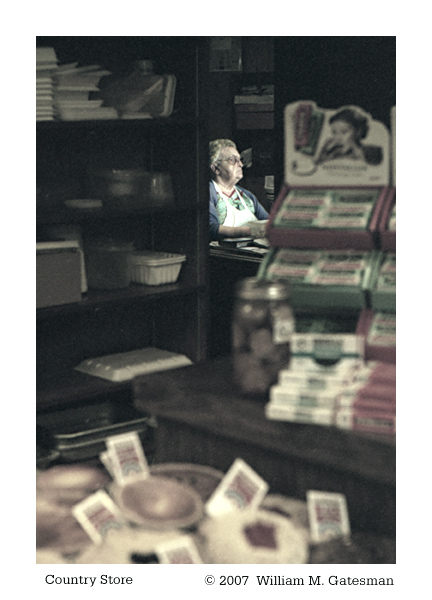
One may surmise by looking at my Photo Gallery that I pay close attention to depth of field when taking photographs. Depth of field is the technical phenomenon that causes some parts of a photograph to be in focus and some to be out of focus. Depth of field traditionally has been caused by the relationship of the lens aperture (the size of the hole that lets light into the camera) and the size of the film. The larger the piece of film, the shorter the depth of field (meaning more of the image will be out of focus). That is why large format view cameras tend to produce images with a short depth of field at many aperture settings. As the film one uses gets smaller in size more of the image is in focus. Hence, 35mm cameras allow for a more in focus image than medium and large format cameras.
I took the photograph above, Country Store, with a 35mm film camera. I was able to set the film camera so that my subject, the woman in the back room, is in focus, and everything else in the foreground is out of focus. In my view, this short depth of field which empasizes certain elements of the image makes a much more interesting photograph than if everything was in focus. Country Store is featured in the Travel Portraits gallery at www.wmgphoto.com
To learn about the challenge of creating a short depth of field using a digital camera, click here ——> Read the rest…
November 9, 2007
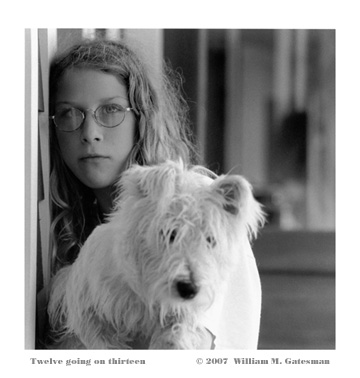
Daniel Oppenheimer, in writing about the photographer, Diane Arbus, states that her “brilliance was to catch everybody unmasked, at the moment of transition between unconscious repose and practiced, social self-representation. People seemed to reveal, in that moment, their essential being . . .”
My objective in making photographic portraits is to do the same thing, although more often than not it happens by chance when I simply am taking someone’s picture. I think I have been successful in capturing my subject in that “moment of transition” in the photograph, Twelve going on thirteen.
I think that such “moment of transition” as it is represented in this photograph is a good metaphor for a budding young woman’s emotional state as she transitions from the state of being a child to the state of being a teenager. I invite you to consider also whether the background in the photograph contributes to that sense of meaning.
Twelve going on thirteen is featured in the Portraits gallery at www.wmgphoto.com
David Oppenheimer’s biography of Diane Arbus is located — Here —
November 1, 2007
Paul Indigo, in his blog Beyond the Obvious has stated that: “If you look at the great masters of photography and their images, many of which have become iconic, you see that there is a distinct gap between text book perfection and what they’ve produced. Most great pictures that touch our hearts have technical flaws. . . . But it doesn’t matter because there’s so much emotion and power in their images.”
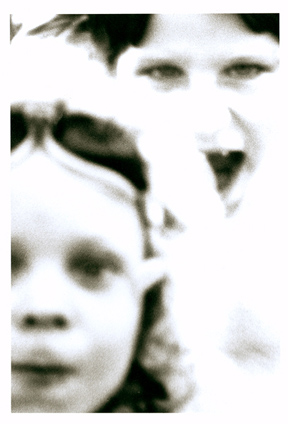 The image in this post, Boys at Play, is a scan of a black and white photograph I created in a traditional wet darkroom. The negative for this image contains much more visual information than the print, however I used an Ilford Mutigrade filter on my enlarger which had the effect of creating the more posterized image you see here. I suppose one might be able to create a similar effect using the posterize feature in photoshop, but I don’t know if that would yield the same result with this image as I obtained using traditional photo processing techniques.
The image in this post, Boys at Play, is a scan of a black and white photograph I created in a traditional wet darkroom. The negative for this image contains much more visual information than the print, however I used an Ilford Mutigrade filter on my enlarger which had the effect of creating the more posterized image you see here. I suppose one might be able to create a similar effect using the posterize feature in photoshop, but I don’t know if that would yield the same result with this image as I obtained using traditional photo processing techniques.
Given the posterized nature of this picture, one might argue that it is not a technically perfect representation of the subject. Nevertheless, for me, it is an effective photograph because, without fail, I have an intense emotional reaction every time I view Boys at Play.
The same can be said about “Robert Capa’s shots of the Normandy landing”, to give but one of the examples pointed out by Paul Indigo. Capa’s photograph of a soldier wading in the ocean towards the shore is blurry and grainy and by no means a technically perfect image, but it is one to which I have a strong emotional response. For me, this photograph successfully captures what it must have been like to be that soldier in that circumstance.
With Boys at Play my response is something akin to dread. But, being the father of two sons, I know that boys (and their dads) often engage in rough play, play that to an outside observer may appear to be something more sinister. I believe that Boys at Play is a successful image insofar as it captures the sinister-looking nature of the interaction between two boys.
You may view a larger version of Boys at Play by logging on to the Surreal Portraits Gallery at my online Photo Gallery at www.wmgphoto.com by clicking –here–
To view Paul Indigo’s blog post Great images may be techically flawed, click –here–
Robert Capa’s most famous Normandy landing photograph can be viewed –here–
________________________________________
Paul Indigo comments:
“Interesting article and I appreciate the way you share your personal feelings about Boys at Play. The emotion in the image hits you straight away and photography is after all about communication, not slavishly following a set of dogmatic rules. I suppose the idea that you and I are trying to get across can be summed up in a simple question: ‘Do you want to be the best rule follower in the world or the best visual communicator?'”
October 27, 2007
 The 2007 Maryland Renaissance Festival has ended. I attended several times and walked around taking pictures.As a groupie to my friend, Charlotte’s women’s quartet, Seraphim, I naturally shot a lot of photos of their performances.
The 2007 Maryland Renaissance Festival has ended. I attended several times and walked around taking pictures.As a groupie to my friend, Charlotte’s women’s quartet, Seraphim, I naturally shot a lot of photos of their performances.
Seraphim performs each year at the Rennaisance fair, but also offers a traditional Christmas program. In addition, the ladies transform themselves into an Andrews Sister’s inspired quartet to perform music from the 1940’s.
My collection of Seraphim photos is featured in the Focus on Seraphim gallery.
The web address for that gallery is http://seraphim.wmgphoto.com/.
You may contact Seraphim for more information about their programs by sending email to SeraphimQuartet@aol.com.
October 10, 2007
There are numerous ways to convert color photos to black and white in Photoshop. Simply changing the mode to grayscale or desaturating the photo are two simple methods that often result in a flat uninteresting image. A more sophisticated approach is to open the Photoshop Channels tab to find the three separate channels for red, green, and blue. Sometimes choosing only one channel and discarding the other two results in a richer and more compelling black and white image when ultimately converted to grayscale.
Hanging On a Pole,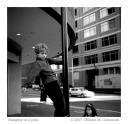 is an example of a rich photograph produced in this manner. While I shot this photo using black and white film, I nevertheless scanned it as a color image, thereby creating three channels of information, although it was shades of black, white, and grey in the three primary color channels.
is an example of a rich photograph produced in this manner. While I shot this photo using black and white film, I nevertheless scanned it as a color image, thereby creating three channels of information, although it was shades of black, white, and grey in the three primary color channels.
Another photograph, Ocean City, 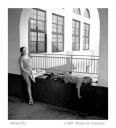 was problematical because the light outside the archway was so bright compared to the internal scene that no one color channel worked in both segments of the image. Consequently, I kept only the red channel for the internal segment of that photo and the green channel for the windows outside. This process resulted in a nicely developed image.
was problematical because the light outside the archway was so bright compared to the internal scene that no one color channel worked in both segments of the image. Consequently, I kept only the red channel for the internal segment of that photo and the green channel for the windows outside. This process resulted in a nicely developed image.
To best appreciate these two photos, please visit The Gatesman Photo Gallery. At the gallery display pages, be sure to keep clicking on the image until you see it at its highest resolution.







